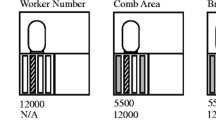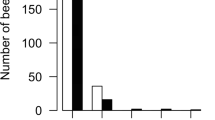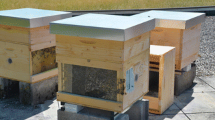Abstract
A honeybee colony needs to divide its workforce so that each of the many tasks it performs has an appropriate number of workers assigned to it. This task allocation system needs to be flexible enough to allow the colony to quickly adapt to an ever-changing environment. In this study, we examined possible mechanisms by which a honeybee colony regulates the division of labor between scouts (foragers that search for new food sources without having been guided to them) and recruits (foragers that were guided via recruitment dances toward food sources). Specifically, we examined the roles that the availability of recruitment dances and worker genotype has in the colony-level regulation of the number of workers engaged in scouting. Our approach was threefold. We first developed a mathematical model to demonstrate that the decision to become a scout or a recruit could be regulated by whether a potential forager can find a recruitment dance within a certain time period. We then tested this model by investigating the effect of dance availability on the regulation of scouts in the field. Lastly, we investigated if the probability of being a scout has a genetic basis. Our field data supported the hypothesis that scouts are those foragers that have failed to locate a recruitment dance as predicted by our model, but we found no effect of genotype on the propensity of foragers to become scouts.






Similar content being viewed by others
References
Beekman M, Ratnieks FLW (2000) Long range foraging by the honeybee Apis mellifera L. Funct Ecol 14:490–496
Beekman M, Sumpter DJT, Ratnieks FLW (2001) Phase transition between disorganised and organised foraging in Pharaoh’s ants. Proc Natl Acad Sci USA 98:9703–9706
Beekman M, Sumpter DJT, Seraphides N, Ratnieks FLW (2004) Comparing foraging behaviour of small and large honey bee colonies by decoding waggle dances made by foragers. Funct Ecol 18:829–835
Beekman M, Fathke RL, Seeley TD (2006) How does an informed minority of scouts guide a honeybee swarm as it flies to its new home? Anim Behav 71:161–171
Biesmeijer JC, Ermers MCW (1999) Social foraging in stingless bees: how colonies of Melipona fasciata choose among nectar sources. Behav Ecol Sociobiol 46:129–140
Biesmeijer JC, Seeley TD (2005) The use of waggle dance information by honey bees throughout their foraging careers. Behav Ecol Sociobiol 59:133–142
Biesmeijer JC, Vries de H (2001) Exploration and exploitation of food sources by social insect colonies: a revision of the scout-recruit concept. Behav Ecol Sociobiol 49:89–99
Brown MJF, Gordon DM (2000) How resources and encounters affect the distribution of foraging activity in a seed-harvesting ant. Behav Ecol Sociobiol 47:195–203
Calderone NW, Page RE (1988) Genotypic variability in age polyethism and task specialization in the honey bee, Apis mellifera (Hymenoptera: Apidae). Behav Ecol Sociobiol 22:17–25
Calderone NW, Page RE (1992) Effects of interactions among genotypically diverse nestmates on task specialization by foraging honey bees (Apis mellifera). Behav Ecol Sociobiol 30:219–226
Camazine S, Sneyd J (1991) A model of collective nectar source selection by honey bees: self-organization through simple rules. J Theor Biol 149:547–571
Cohen J (1992) A power primer. Psychol Bull 112:155–159
Deneubourg J-L, Pasteels JM, Verhaeghe JC (1983) Probabilistic behaviour in ants: a strategy of errors? J Theor Biol 105:259–271
Deneubourg J-L, Aron S, Goss S, Pasteels JM (1987) Error, communication and learning in ant societies. Eur J Oper Res 30:168–172
Dreller C (1998) Division of labor between scouts and recruits: genetic influence and mechanisms. Behav Ecol Sociobiol 43:191–196
Dreller C, Fondrk MK, Page RE (1995) Genetic variability affects the behavior of foragers in a feral honeybee colony. Naturwissenschaften 80:231–266
Erdfelder E, Faul F, Buchner A (1996) GPOWER: a general power analysis program. Behav Res Meth Instrum Comput 28:1–11
Estoup A, Solignac M, Cornuet J-M (1994) Precise assessment of the number of patrilines and of genetic relatedness in honey bee colonies. Proc R Soc Lond B 258:1–7
Fewell JH (2003) Social insect networks. Science 301:1867–1870
Fewell JH, Bertram SM (1999) Division of labor in a dynamic environment: response by honeybees (Apis mellifera) to graded changes in colony pollen stores. Behav Ecol Sociobiol 46:171–179
von Frisch K (1923) Über die “Sprache” der Bienen, eine tier-psychologische Untersuchung. Zool Jahrb 40:1–186
von Frisch K (1967) The dance language and orientation of bees. Harvard University Press, Cambridge, MA
Janson S, Middendorf M, Beekman M (2007) Searching for a new home scouting behavior of honeybee swarms. Behavioral Ecology in press
Jones JC, Myerscough MR, Graham S, Oldroyd BP (2004) Honey bee nest thermoregulation: diversity promotes stability. Science 305:402–404
Lindauer M (1952) Ein Beitrag zur Frage der Arbeitsteilung im Bienenstaat. Z Vgl Physiol 34:299–345
Myerscough MR, Oldroyd BP (2004) Simulation models of the role of genetic variability in social insect task allocation. Insectes Soc 51:146–152
Oettingen-Spielberg Tz (1949) Über das Wesen der Suchbiene. Z Vgl Physiol 31:454–489
Oldroyd BP, Smolenski A, Cornuet J-M, Wongsiri S, Estoup A, Rinderer TE, Crozier RH (1996) Levels of polyandry and intracolonial genetic relationships in Apis dorsata (Hymenoptera: Apidae). Ann Entomol Soc Am 89:276–283
Page RE, Waddington KD, Hunt GJ, Fondrk MK (1995) Genetic determinants of honey bee foraging behaviour. Anim Behav 50:1617–1625
Page RE, Erber J, Fondrk MK (1998) The effect of genotype on response threshold to sucrose and foraging behavior of honey bees (Apis mellifera L.). J Comp Physiol [A] 182:489–500
Palmer KA, Oldroyd BP (2000) Evolution of multiple mating in the genus Apis. Apidologie 31:235–248
Passino KM, Seeley TD (2006) Modeling and analysis of nest-site selection by honeybee swarms: the speed and accuracy trade-off. Behav Ecol Sociobiol 59:427–442
Pasteels JM, Deneubourg J-L, Goss S (1987) Self-organization mechanisms in ant societies (I): trail recruitment to newly discovered food sources. Experientia Suppl 54:155–175
Schneider SS (1989) Spatial foraging patterns of the African honeybee, Apis mellifera scutellata. J Insect Behav 2:505–521
Seeley TD (1983) Division of labor between scouts and recruits in honeybee foraging. Behav Ecol Sociobiol 12:253–259
Seeley TD (1995) The wisdom of the hive. Harvard University Press, Cambridge, MA
Seeley TD, Camazine S, Sneyd J (1991) Collective decision-making in honey bees: how colonies choose among nectar sources. Behav Ecol Sociobiol 28:277–290
Sumpter DJT (2000) From bee to society: an agent-based investigation of honey bee colonies. Ph.D. thesis, University of Manchester, Manchester
Sumpter DJT (2005) The principles of collective animal behaviour. Philos Trans R Soc Lond B 361:5–22
Sumpter DJT, Beekman M (2003) From non-linearity to optimality: pheromone trail foraging by ants. Anim Behav 66:273–280
Sumpter DJT, Pratt SC (2003) A modelling framework for understanding social insect foraging. Behav Ecol Sociobiol 53:131–144
Theraulaz G, Bonabeau E, Deneubourg J-L (1998) Response threshold reinforcement and division of labour in insect societies. Proc R Soc Lond B 265:327–332
Visscher PK, Seeley TD (1982) Foraging strategy of honeybee colonies in a temperate deciduous forest. Ecology 63:1790–1801
Waddington KD, Visscher PK, Herbert TJ, Raveret Richter M (1994) Comparisons of forager distributions from matched honey bee colonies in suburban environments. Behav Ecol Sociobiol 35:423–429
Zar JH (1996) Biostatistical analysis. Prentice-Hall, Upper Saddle River, NJ
Acknowledgements
We would like to thank David Deas, Rosalind Gloah, Alex Jordan, Julie Lim, Ben Oldroyd, Peter Oxley, and Sheree Yau for helping us mark enormous numbers of bees; Stuart Gilchrist, Alex Jordan, Julie Lim, and Sheree Yau for their help in the field; Nadine Chapman for her help in the lab; the School of Biological Sciences for the use of the Crommelin Biological Research Station; and the University of Western Sydney for the use of one of their field sites. Special thanks to Ben Oldroyd for his elaborate comments on previous versions of this manuscript, and Tom Seeley and Stephen Pratt for their constructive criticisms. MB is funded by the Australian Research Council. DJTS is funded by the Royal Society.
Author information
Authors and Affiliations
Corresponding author
Additional information
Communicated by R. Page
Rights and permissions
About this article
Cite this article
Beekman, M., Gilchrist, A.L., Duncan, M. et al. What makes a honeybee scout?. Behav Ecol Sociobiol 61, 985–995 (2007). https://doi.org/10.1007/s00265-006-0331-9
Received:
Revised:
Accepted:
Published:
Issue Date:
DOI: https://doi.org/10.1007/s00265-006-0331-9




